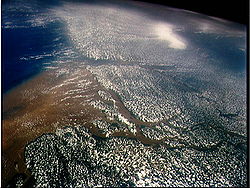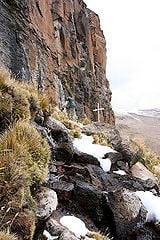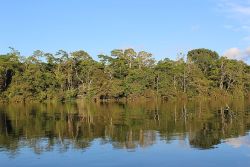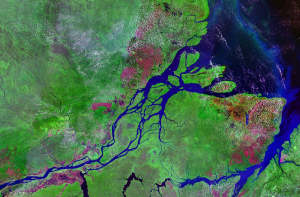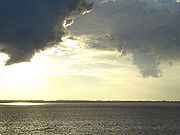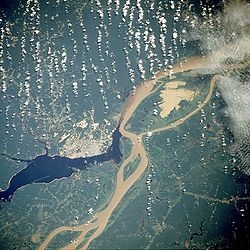Amazon River
Your continued donations keep Wikipedia running! Editing Amazon River From Wikipedia, the free encyclopedia Jump to: navigation, search You are not currently logged in. While you are free to edit without logging in, your IP address will be recorded in this page's edit history. Creating an account will conceal your IP address and provide you with many other benefits.
Template:Infobox River Geography
The Amazon River or River Amazon (Portuguese: Rio Amazonas; Spanish: Río Amazonas) of South America is the largest river in the world by volume, with six times greater total river flow than the next six largest rivers combined, and the largest drainage basin in the world. Because of its vast dimensions it is sometimes called The River Sea. Most sources regard the Amazon as the second longest river in length, though this is a matter of some dispute.
The area covered by the Amazon River and its tributaries more than triples over the course of a year. In an average dry season 110,000 square km of land are water-covered, while in the wet season the flooded area of the Amazon Basin rises to 350,000 square km.[citation needed] At its widest point the Amazon River can be 11 km/6.8 mi wide during the dry season, but during the rainy season when the Amazon River floods the surrounding plains it can be up to 40 km/24.8 mi wide.
The quantity of fresh water released by the Amazon to the Atlantic Ocean is enormous: up to 300,000 m³ per second in the rainy season. The Amazon is responsible for a fifth of the total volume of fresh water entering the oceans worldwide. Offshore of the mouth of the Amazon, potable water can be drawn from the ocean while still out of sight of the coastline, and the salinity of the ocean is notably lower a hundred miles out to sea.
The Amazon estuary is over 325 km/202 mi wide. The main river (which is between approximately one and six miles wide) is navigable for large ocean steamers to Manaus, 1,500 km (more than 900 miles) upriver from the mouth. Smaller ocean vessels of 3,000 tons[1] and 5.5 m (18 ft) draft can reach as far as Iquitos, Peru, 3,600 km (2,250 miles) from the sea. Smaller riverboats can reach 780 km (486 mi) higher as far as Achual Point. Beyond that, small boats frequently ascend to the Pongo de Manseriche, just above Achual Point.
The Amazon drains an area of some 6,915,000km² (2,722,000 mile²), or some 40 percent of South America. It gathers its waters from 5 degrees north latitude to 20 degrees south latitude. Its most remote sources are found on the inter-Andean plateau, just a short distance from the Pacific Ocean; and, after a course of about 6,400 km (4,000 mi) through the interior of Peru and across Brazil, it enters the Atlantic Ocean at the equator.
The Amazon has changed its drainage several times, from westward in the early Cenozoic to its present eastward locomotion following the uplift of the Andes.[2]
Source and Upper Amazon
The Upper Amazon comprises a series of major river systems in Peru that flow north and south into the Marañón and Amazon. Among others, these include the following rivers: Morona; Pastaza; Nucuray; Urituyacu; Chambira; Tigre; Nanay; Napo; Huallaga; and Ucayali. Originating in the snow-crested Andes high above Lake Lauricocha in central Peru, the headstream of the Marañón River rises in the glaciers in what is known as the Nevado de Yarupa. Rushing through waterfalls and gorges in an area of the high jungle called the pongos, the Marañón River flows about 1,000 miles from west-central to northeast Peru before it combines with the Ucayali River, just below the provincial town of Nauta, to form the mighty Amazon River. The primary tributaries of the Marañón River are—from south to north—the Crisnejas, Chamayo, Urtcubamba, Cenepa, Santiago, Moroña, Pastaza, Huallaga, and Tiger Rivers (Cavero-Egusquiza 1941:49-51).
The most distant source of the Amazon has only recently been firmly established as a glacial stream on a snowcapped 5,597 metre (18,363 ft) peak called Nevado Mismi[3] in the Peruvian Andes, roughly 160 km west of Lake Titicaca and 700 km S.E. of Lima. The mountain was first suggested as the source in 1971 but this was not confirmed until 2001. The waters from Nevado Mismi flow into the Quebradas Carhuasanta and Apacheta, which flow into the Río Apurímac which is a tributary of the Ucayali which later joins the Marañón to form the Amazon proper. Formally, though, the union of the Ucayali and the Marañón form the Río Amazonas, which changes its name to Solimões on the triple frontier between Peru, Colombia and Brazil, and later changes its name back to the Amazon only after it meets the Rio Negro near Manaus.
After the confluence of Río Apurímac and Ucayali, the river leaves Andean terrain and is instead surrounded by flood plain. From this point to the Marañón, some 1,600 km (1,000 mi), the forested banks are just out of water, and are inundated long before the river attains its maximum flood-line. The low river banks are interrupted by only a few hills, and the river enters the enormous Amazon Rainforest.
The river systems and flood plains in Brazil, Peru, Ecuador, Colombia and Venezuela whose waters drain into the Solimões and its tributaries are called the "Upper Amazon".
Amazonian Rainforest
From the east of the Andes, the Amazon Rainforest begins. It is the largest rainforest in the world and is of great ecological significance, as its biomass is capable of absorbing enormous amounts of carbon dioxide. Conservation of the Amazon Rainforest has been a major issue in recent years.
The rainforest is supported by the extremely wet climate of the Amazon basin. The Amazon, and its hundreds of tributaries, flow slowly across the landscape, with an extremely shallow gradient sending them towards the sea: Manaus, 1,600 km (1,000 mi) from the Atlantic, is only 44 m (144 ft) above sea level.
The biodiversity within the rainforest is extraordinary: the region is home to at least 2.5 million insect species, tens of thousands of plants, and some 2,000 birds and mammals. One fifth of all the world's species of birds can be found in the Amazon rainforest.
The diversity of plant species in the Amazon basin is the highest on Earth. Some experts estimate that one square kilometre may contain over 75,000 types of trees and 150,000 species of higher plants. One square kilometre of Amazon rainforest can contain about 90,000 tons of living plants.
Flooding
The average depth of the river in the height of the rainy season is 40 m (120 ft) and the average width can be nearly twenty-five miles[citation needed]. It starts to rise in November, and increases in volume until June, then falls until the end of October. The rise of the Negro branch is not synchronous; the rainy season does not commence in its valley until February or March. By June it is full, and then it begins to fall with the Amazon. The Madeira rises and falls two months earlier than the Amazon.
Towards the sea
The breadth of the Amazon in some places is as much as 6 to 10 km (4 to 6 mi) from one bank to the other[citation needed]. At some points, for long distances, the river divides into two main streams with inland and lateral channels, all connected by a complicated system of natural canals, cutting the low, flat igapo lands, which are never more than 5 m (15 ft) above low river, into many islands.
At the narrows of Óbidos, 600 km (400 mi) from the sea, the Amazon narrows, flowing in a single streambed, a mile (1.6 km) wide and over 200 ft (60 m). deep, through which the water rushes toward the sea at the speed of 6 to 8 km/h (4 to 5 mph).
From the village of Canaria at the great bend of the Amazon to the Negro 1,000 km (600 mi) downstream, only very low land is found, resembling that at the mouth of the river. Vast areas of land in this region are submerged at high water, above which only the upper part of the trees of the sombre forests appear. Near the mouth of the Rio Negro to Serpa, nearly opposite the river Madeira, the banks of the Amazon are low, until approaching Manaus, they rise to become rolling hills. At Óbidos, a bluff 17 m (56 ft) above the river is backed by low hills. The lower Amazon seems to have once been a gulf of the Atlantic Ocean, the waters of which washed the cliffs near Óbidos.
Only about 10% of the water discharged by the Amazon enters the mighty stream downstream of Óbidos, very little of which is from the northern slope of the valley. The drainage area of the Amazon basin above Óbidos is about 5 million km² (2 million mile²), and, below, only about 1 million km² (400,000 mile²), or around 20%, exclusive of the 1.4 million km² (600,000 mile²) of the Tocantins basin.
In the lower reaches of the river, the north bank consists of a series of steep, table-topped hills extending for about 240 km (150 mi) from opposite the mouth of the Xingu as far as Monte Alegre. These hills are cut down to a kind of terrace which lies between them and the river.
Monte Alegre reaches an altitude of several hundred feet. On the south bank, above the Xingu, an almost-unbroken line of low bluffs bordering the flood-plain extends nearly to Santarem, in a series of gentle curves before they bend to the south-west, and, abutting upon the lower Tapajos, merge into the bluffs which form the terrace margin of the Tapajos river valley.
Mouth of the river
The width of the mouth of the river is usually measured from Cabo do Norte to Punto Patijoca, a distance of some 330 km (207 mi); but this includes the ocean outlet, 60 km (40 mi) wide, of the Para river, which should be deducted, as this stream is only the lower reach of the Tocantins. It also includes the ocean frontage of Marajó, an island about the size of Denmark lying in the mouth of the Amazon.
Tidal bore
Following the coast, a little to the north of Cabo do Norte, and for 160 km (100 miles) along its Guiana margin up the Amazon, is a belt of half-submerged islands and shallow sandbanks. Here the tidal phenomenon called the bore, or pororoca, occurs, where the depths are not over 4 fathoms (7 m). The tidal bore starts with a roar, constantly increasing, and advances at the rate of from 15 to 25 km/h (10 to 15 mph), with a breaking wall of water from 1.5 to 4 m (5 to 12 ft) high. The bore is the reason the Amazon does not have a delta; the ocean rapidly carries away the vast volume of silt carried by the Amazon, making it impossible for a delta to grow. It also has a very large tide sometimes reaching 20 feet.
Wildlife
The waters of the Amazon support a diverse range of wildlife. Along with the Orinoco, the river is one of the main habitats of the Boto, also known as the Amazon River Dolphin. The largest species of river dolphin, it can grow to lengths of up to 2.6 m.
Also present in large numbers are the notorious Piranha, carnivorous fish which congregate in large schools, and may attack livestock and even humans. Although many experts believe their reputation for ferocity is unwarranted, a school of piranha was apparently responsible for the deaths of up to 300 people when their boat capsized near Óbidos in 1981. [citation needed] However, only a few species attack humans, and many are solely fish-eaters, and do not school.
The Anaconda snake is found in shallow waters in the Amazon basin. One of the world's largest species of snake, the Anaconda spends most of its time in the water, with just its nostrils above the surface. Anacondas have been known to occasionally attack fishermen.
The river also supports thousands of species of fish, as well as crabs and turtles.
European exploration
The first descent by a European of the Amazon from the Andes to the sea was made by Francisco de Orellana in 1541.
The first ascent by a European of the river was made in 1638 by Pedro Teixeira, a Portuguese, who reversed the route of Orellana and reached Quito by way of the Napo River. He returned in 1639 with the two Jesuit fathers Acuña and Artieda, who had been delegated by the viceroy of Peru to accompany Texeira.
In 2007 the Slovenian long-distance swimmer Martin Strel will attempt to swim in seventy days the entire length of the river, from Atalaya, Peru to the Atlantic Ocean.[4]
Name
Before the conquest of South America, the Rio Amazonas had no general name; instead, indigenous peoples had names for the sections of the river they occupied, such as Paranaguazu, Guyerma, Solimões and others.
In the year 1500, Vicente Yañez Pinzon, in command of a Spanish expedition, became the first European to explore the river, exploring its mouth when he discovered that the ocean off the shore was fresh water. Pinzon called the river the Rio Santa Maria de la Mar Dulce, which soon became abbreviated to Mar Dulce, and for some years, after 1502, it was known as the Rio Grande.
Pinzon's companions called the river El Río Marañón. The word Marañón is thought by some to be of indigenous origin. This idea was first stated in a letter from Peter Martyr to Lope Hurtado de Mendoza in 1513. However, the word may also be derived from the Spanish word "maraña" — meaning a tangle, a snarl, which well represents the bewildering difficulties which the earlier explorers met in navigating not only the entrance to the Amazon, but the whole island-bordered, river-cut and indented coast of what is now the Brazilian state of Maranhão.
The name Amazon arises from a battle which Francisco de Orellana had with a tribe of Tapuyas where the women of the tribe fought alongside the men, as was the custom among the entire tribe. Orellana derived the name Amazonas from the ancient Amazons of Asia and Africa described by Herodotus and Diodorus.
The Colonial Encounter & Amazonia
During what many archaeologists call the formative period, Amazonian societies were deeply implicated in the emergence of South America's highland agrarian systems, and possibly contributed directly to the social and religious fabric constitutive of the Andean civilizational orders[1].
For 350 years after the European discovery of the mighty Amazon by Pinzon, the Portuguese portion of the basin remained a virtually undisturbed wilderness, occupied by Indigenous peoples. While there is ample evidence for large-scale, pre-Columbian social formations, including chiefdoms, in many areas of Amazonia (particularly the inter-fluvial regions) the former indigenous inhabitants probably had relatively low population densities.
In what is currently Brazil, Ecuador, Bolivia, Colombia, Peru, and Venezuela a number of colonial and religious settlements were established along the banks of primary rivers and tributaries for the purpose of trade, slaving and evangelization among the putatively savage indigenous peoples of the vast rain forest.
The total population of the Brazilian portion of the Amazon basin in 1850 was perhaps 300,000, of whom about two-thirds comprised by Europeans and slaves, the slaves amounting to about 25,000. In Brazil, the principal commercial city, Para, had from 10,000 to 12,000 inhabitants, including slaves. The town of Manáos, now Manaus, at the mouth of the Rio Negro, had from 1,000 to 1,500 population. All the remaining villages, as far up as Tabatinga, on the Brazilian frontier of Peru, were relatively small.
On September 6 1850, the emperor, Dom Pedro II, sanctioned a law authorizing steam navigation on the Amazon, and gave Barão de Mauá (Irineu Evangilista de Sousa) the task of putting it into effect. He organized the "Compania de Navigacao e Commercio do Amazonas" at Rio de Janeiro in 1852; and in the following year it commenced operations with three small steamers, the Monarch, the Marajó and Rio Negro.
At first, navigation was principally confined to the main river; and even in 1857 a modification of the government contract only obliged the company to a monthly service between Pará and Manaus, with steamers of 200 tons cargo capacity, a second line to make six round voyages a year between Manaus and Tabatinga, and a third, two trips a month between Para and Cameta. This was the first step in opening up the vast interior.
The success of the venture called attention to the opportunities for economic exploitation of the Amazon, and a second company soon opened commerce on the Madeira, Purus and Negro; a third established a line between Pará and Manaus; and a fourth found it profitable to navigate some of the smaller streams. In that same period, the Amazonas Company was increasing its fleet. Meanwhile, private individuals were building and running small steam craft of their own on the main river as well as on many of its tributaries.
On July 31 1867 the government of Brazil, constantly pressed by the maritime powers and by the countries encircling the upper Amazon basin, especially Peru, decreed the opening of the Amazon to all flags; but limited this to certain defined points: Tabatinga—on the Amazon; Cameta—on the Tocantins; Santarem—on the Tapajos; Borba—on the Madeira and Manáos—on the Rio Negro. The Brazilian decree took effect on September 7 1867.
Thanks in part to the mercantile development associated with steam boat navigation, coupled with the internationaly driven demand for natural rubber (1880-1920), Manáos (now Manaus), Para (Brasil), and Iquitos, Peru became thriving, cosmopolitan centers of commerce and spectular—albeit illusory—modern "urban growth". This was particularly the case for Iquitos during its late 19th and early 20th century Rubber Bonanza zenith when this dynamic boom-town was known abroad as the St. Louis of the Amazon.
The first direct foreign trade with Manáos was commenced around 1874. Local trade along the river was carried on by the English successors to the Amazonas Company—the Amazon Steam Navigation Company—as well as numerous small steamboats, belonging to companies and firms engaged in the rubber trade, navigating the Negro, Madeira, Purfis and many other tributaries, such as the Marañón to ports as distant as Nauta, Peru.
By the turn of the 20th century, the principal exports of the Amazon Basin were india-rubber, cacao, Brazil nuts and a few other products of minor importance, such as pelts and exotic forest produce (resins, barks, woven hammocks, prized bird feathers, live animals, etc.) and extracted goods (lumber, gold, etc.).. .
20th century concerns
Four centuries after the European discovery of the Amazon river, the total cultivated area in its basin was probably less than 25 square miles (65 km²), excluding the limited and crudely cultivated areas among the mountains at its extreme headwaters. This situation changed dramatically during the 20th century.
Wary of foreign exploitation of the nation's resources, Brazilian governments in the 1940s set out to develop the interior, away from the seaboard where foreigners owned large tracts of land. The original architect of this expansion was President Getúlio Vargas, the demand for rubber from the Allied forces in World War II providing funding for the drive.
The construction of the new capital Brasilia in the interior in 1960 also contributed to the opening up of the Amazon basin. A large scale colonization program saw families from north-eastern Brazil relocated to the forests, encouraged by promises of cheap land. Many settlements grew along the road from Brasilia to Belém, but rainforest soil proved difficult to cultivate.
Still, long-term development plans continued. Roads were cut through the forests, and in 1970, the work on Trans-Amazon highway network began. The network's three pioneering highways were completed within ten years, connecting all the major cities of the Brazilian Amazon interior.
Cattle farming became a major impetus in deforestation, with military governments in the 1960s and 1970s heavily subsidising the creation of large ranches. By the 1980s the rate of destruction of the rainforest was dizzying, and it is estimated that over a fifth of the total area of the rainforest has now been clearcut. The preservation of the remaining forest is becoming an ever more prominent concern.
Major tributaries
The Amazon has over 1,000 tributaries in total. Some of the more notable:
|
|
Longest rivers in the Amazon system
- 6,387 km - Amazon, South America
- 3,379 km - Purus, Peru / Brazil, (2,948 km) (3,210 km)
- 3,239 km - Madeira, Bolivia / Brazil
- 2,820 km - Yapura, Colombia / Brazil
- 2,750 km - Tocantins, Brazil, (2,416 km) (2,640 km)
- 2,575 km - Araguaia, Brazil (tributary of Tocantins)
- 2,410 km - Juruá, Peru / Brazil
- 2,250 km - Negro, South America
- 2,100 km - Xingu, Brazil
- 1,900 km - Tapajós, Brazil
- 1,749 km - Guaporé, Brazil / Bolivia (tributary of Madeira)
- 1,575 km - Içá (Putumayo), South America
- 1,415 km - Marañón, Peru
- 1,300 km - Iriri, Brazil (tributary of Xingu)
- 1,240 km - Juruena, Brazil (tributary of Tapajós)
- 1,200 km - Tapajós, Brazil
- 1,130 km - Madre de Dios, Peru / Bolivia (tributary of Madeira)
- 1,100 km - Huallaga, Peru (tributary of Marañón)
ReferencesISBN links support NWE through referral fees
- ↑ Amazon uk.encarta.msn.com. Retrieved 1 October 2006.
- ↑ Amazon river 'switched direction' bbc.co.uk Retrieved 25 October 2006
- ↑ Explorers Pinpoint Source of the Amazon
- ↑ Buckets of Blood readied for Amazon Swim
- This article incorporates text from the Encyclopædia Britannica Eleventh Edition, a publication now in the public domain.
External links
- Bibliography on Water Resources and International Law See Amazon River. Peace Palace Library
- Amazon River and Amazon Rainforest virtual tour
- Information on the Amazon from Extreme Science
- Map of South America
- Map of South America
- Fundación Gaia Amazonas (English) (Spanish)
- Pictures of the Amazon River
- Amazon River and Amazon rainforest information
- An Amazon River web site
- Information and a map of the Amazon's watershed
- Expedition to the source
am:አማዞን ወንዝ ar:أمازون (نهر) an:Río Amazonas zh-min-nan:Amazonas Hô bn:আমাজন নদী be:Амазонка (рака) bs:Amazon bg:Амазонка (река) ca:Riu Amazones cs:Amazonka da:Amazonfloden de:Amazonas et:Amazonas es:Río Amazonas eo:Amazono (rivero) eu:Amazonas fr:Amazone (fleuve) gl:Río Amazonas ko:아마존 강 hr:Amazona io:Amazon id:Sungai Amazon is:Amasónfljót it:Rio delle Amazzoni he:אמזונאס (נהר) ka:ამაზონი ku:Amazon la:Amazonius lv:Amazone (upe) lb:Amazonas lt:Amazonė (upė) lmo:Riu dii Amazzun hu:Amazonas ml:ആമസോണ് നദി nl:Amazone (rivier) ja:アマゾン川 no:Amazonaselva nn:Amazonaselva pl:Amazonka (rzeka) pt:Rio Amazonas ro:Amazon (fluviu) rm:Amazonas qu:Amarumayu ru:Амазонка (река) ru-sib:Амазонка scn:Ciumi di l'Amazzoni simple:Amazon River sk:Amazon sl:Amazonka sr:Амазон sh:Amazona fi:Amazon (joki) sv:Amazonfloden ta:அமேசான் ஆறு th:แม่น้ำแอมะซอน vi:Sông Amazon tr:Amazon Nehri uk:Амазонка (ріка) ur:دریائے ایمیزون zh:亚马孙河
Content that violates any copyright will be deleted. Encyclopedic content must be verifiable. You agree to license your contributions under the GFDL.
Edit summary (Briefly describe the changes you have made):
Cancel | Editing help (opens in new window)
Do not copy text from other websites without permission. It will be deleted. Insert: – — … ° ≈ ≠ ± − × ÷ ← → · § Sign your name: Susan Fefferman 00:07, 25 January 2007 (UTC)
Wiki markup: {{}} | [] [[]] [[Category:]] #REDIRECT [[]]
Cite error: Invalid <ref> tag; refs with no name must have content
• (templates)
Symbols: ~ | ¡ ¿ † ‡ ↔ ↑ ↓ • ¶ # ¹ ² ³ ½ ⅓ ⅔ ¼ ¾ ⅛ ⅜ ⅝ ⅞ ‘ “ ’ ” ¢ $ € ₦ £ ¥ Characters: Á á Ć ć É é Í í Ĺ ĺ Ń ń Ó ó Ŕ ŕ Ś ś Ú ú Ý ý Ź ź À à È è Ì ì Ò ò Ù ù  â Ĉ ĉ Ê ê Ĝ ĝ Ĥ ĥ Î î Ĵ ĵ Ô ô Ŝ ŝ Û û Ŵ ŵ Ŷ ŷ Ä ä Ë ë Ï ï Ö ö Ü ü Ÿ ÿ ß Ã ã Ẽ ẽ Ĩ ĩ Ñ ñ Õ õ Ũ ũ Ỹ ỹ Ç ç Ģ ģ Ķ ķ Ļ ļ Ņ ņ Ŗ ŗ Ş ş Ţ ţ Đ đ Ů ů Ǎ ǎ Č č Ď ď Ě ě Ǐ ǐ Ľ ľ Ň ň Ǒ ǒ Ř ř Š š Ť ť Ǔ ǔ Ž ž Ā ā Ē ē Ī ī Ō ō Ū ū Ȳ ȳ Ǣ ǣ ǖ ǘ ǚ ǜ Ă ă Ĕ ĕ Ğ ğ Ĭ ĭ Ŏ ŏ Ŭ ŭ Ċ ċ Ė ė Ġ ġ İ ı Ż ż Ą ą Ę ę Į į Ǫ ǫ Ų ų Ḍ ḍ Ḥ ḥ Ḷ ḷ Ḹ ḹ Ṃ ṃ Ṇ ṇ Ṛ ṛ Ṝ ṝ Ṣ ṣ Ṭ ṭ Ł ł Ő ő Ű ű Ŀ ŀ Ħ ħ Ð ð Þ þ Œ œ Æ æ Ø ø Å å Ə ə • Greek: Ά ά Έ έ Ή ή Ί ί Ό ό Ύ ύ Ώ ώ Α α Β β Γ γ Δ δ Ε ε Ζ ζ Η η Θ θ Ι ι Κ κ Λ λ Μ μ Ν ν Ξ ξ Ο ο Π π Ρ ρ Σ σ ς Τ τ Υ υ Φ φ Χ χ Ψ ψ Ω ω • • (polytonic list) Cyrillic: А а Б б В в Г г Ґ ґ Ѓ ѓ Д д Ђ ђ Е е Ё ё Є є Ж ж З з Ѕ ѕ И и І і Ї ї Й й Ј ј К к Ќ ќ Л л Љ љ М м Н н Њ њ О о П п Р р С с Т т Ћ ћ У у Ў ў Ф ф Х х Ц ц Ч ч Џ џ Ш ш Щ щ Ъ ъ Ы ы Ь ь Э э Ю ю Я я IPA: t̪ d̪ ʈ ɖ ɟ ɡ ɢ ʡ ʔ ɸ ʃ ʒ ɕ ʑ ʂ ʐ ʝ ɣ ʁ ʕ ʜ ʢ ɦ ɱ ɳ ɲ ŋ ɴ ʋ ɹ ɻ ɰ ʙ ʀ ɾ ɽ ɫ ɬ ɮ ɺ ɭ ʎ ʟ ɥ ʍ ɧ ɓ ɗ ʄ ɠ ʛ ʘ ǀ ǃ ǂ ǁ ɨ ʉ ɯ ɪ ʏ ʊ ɘ ɵ ɤ ə ɚ ɛ ɜ ɝ ɞ ʌ ɔ ɐ ɶ ɑ ɒ ʰ ʷ ʲ ˠ ˤ ⁿ ˡ ˈ ˌ ː ˑ ̪ •
Your changes will be visible immediately.
For testing, please use the sandbox instead.
On talk pages, please sign your comment by typing four tildes (Susan Fefferman 00:07, 25 January 2007 (UTC)).
Please note: If you don't want your writing to be edited mercilessly or redistributed by others, do not submit it. Only public domain resources can be copied without permission—this does not include the vast majority of web pages or images. See our policies and guidelines for more information on editing. Pages transcluded onto the current version of this page:
Template:! (protected) Template:1911 (protected) Template:Commons (protected) Template:Coor URL (protected) Template:Coor dm (protected) Template:Coor dms (protected) Template:En icon (protected) Template:Es icon (protected) Template:Fact (protected) Template:Geobox image Template:Geobox link Template:Geobox note Template:Geobox row Template:Infobox River Geography Template:Lang (protected) Template:Lang-es Template:Lang-pt Template:LangWithName (protected) Template:Languageicon (protected) Template:Main (protected) Template:Unit cbft-per-s Template:Unit cbm-per-s Template:Unit ft Template:Unit km Template:Unit m Template:Unit mi Template:Unit sqkm Template:Unit sqmi
Retrieved from "http://en.wikipedia.org/wiki/Amazon_River"ViewsArticle Discussion Edit this page History Personal toolsSign in / create account Navigation Main page Community portal Featured content Current events Recent changes Random article Help Contact Wikipedia Donations Search
Toolbox
What links here Related changes Upload file Special pages
Privacy policy About Wikipedia Disclaimers
Credits
New World Encyclopedia writers and editors rewrote and completed the Wikipedia article in accordance with New World Encyclopedia standards. This article abides by terms of the Creative Commons CC-by-sa 3.0 License (CC-by-sa), which may be used and disseminated with proper attribution. Credit is due under the terms of this license that can reference both the New World Encyclopedia contributors and the selfless volunteer contributors of the Wikimedia Foundation. To cite this article click here for a list of acceptable citing formats.The history of earlier contributions by wikipedians is accessible to researchers here:
The history of this article since it was imported to New World Encyclopedia:
Note: Some restrictions may apply to use of individual images which are separately licensed.
